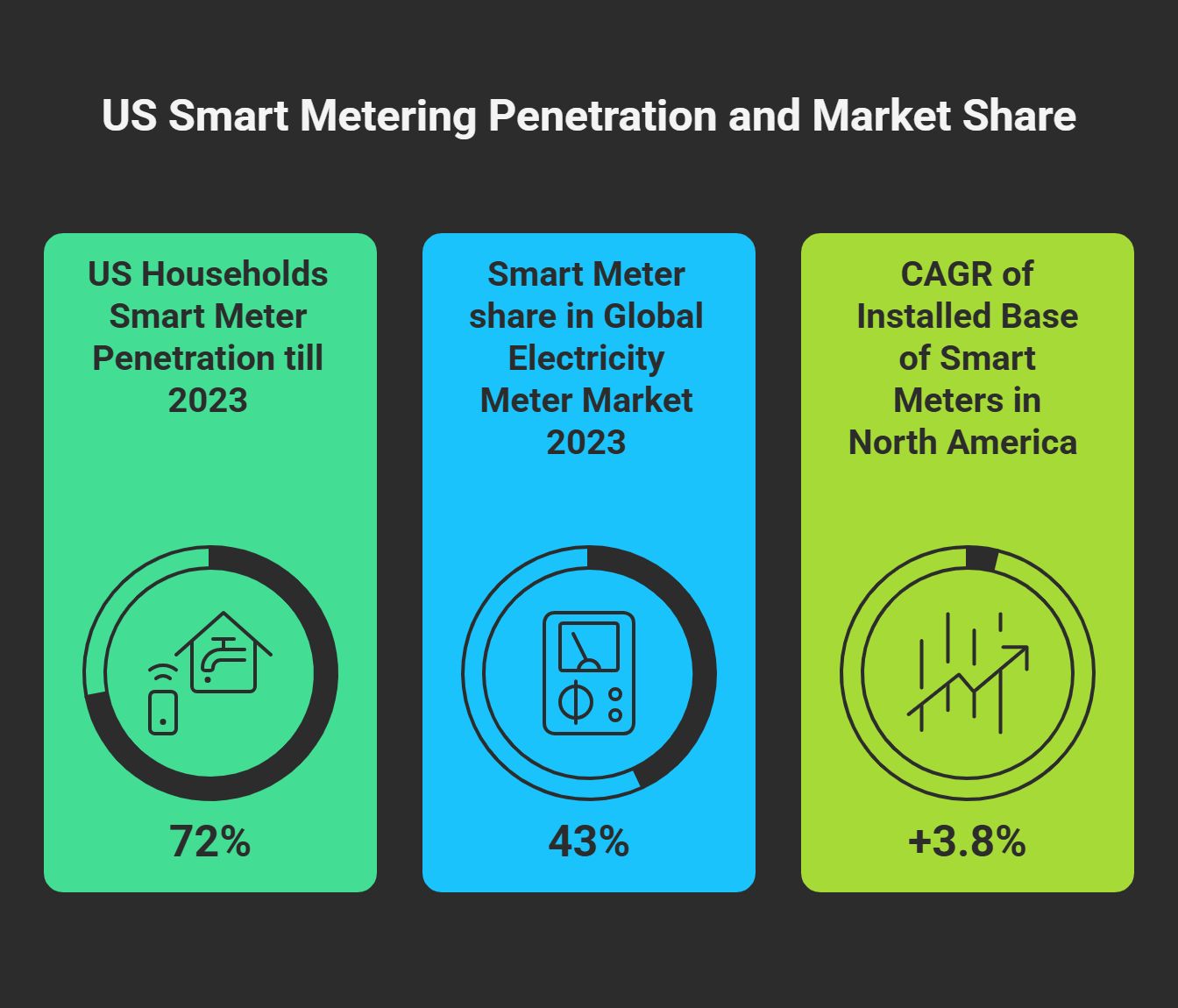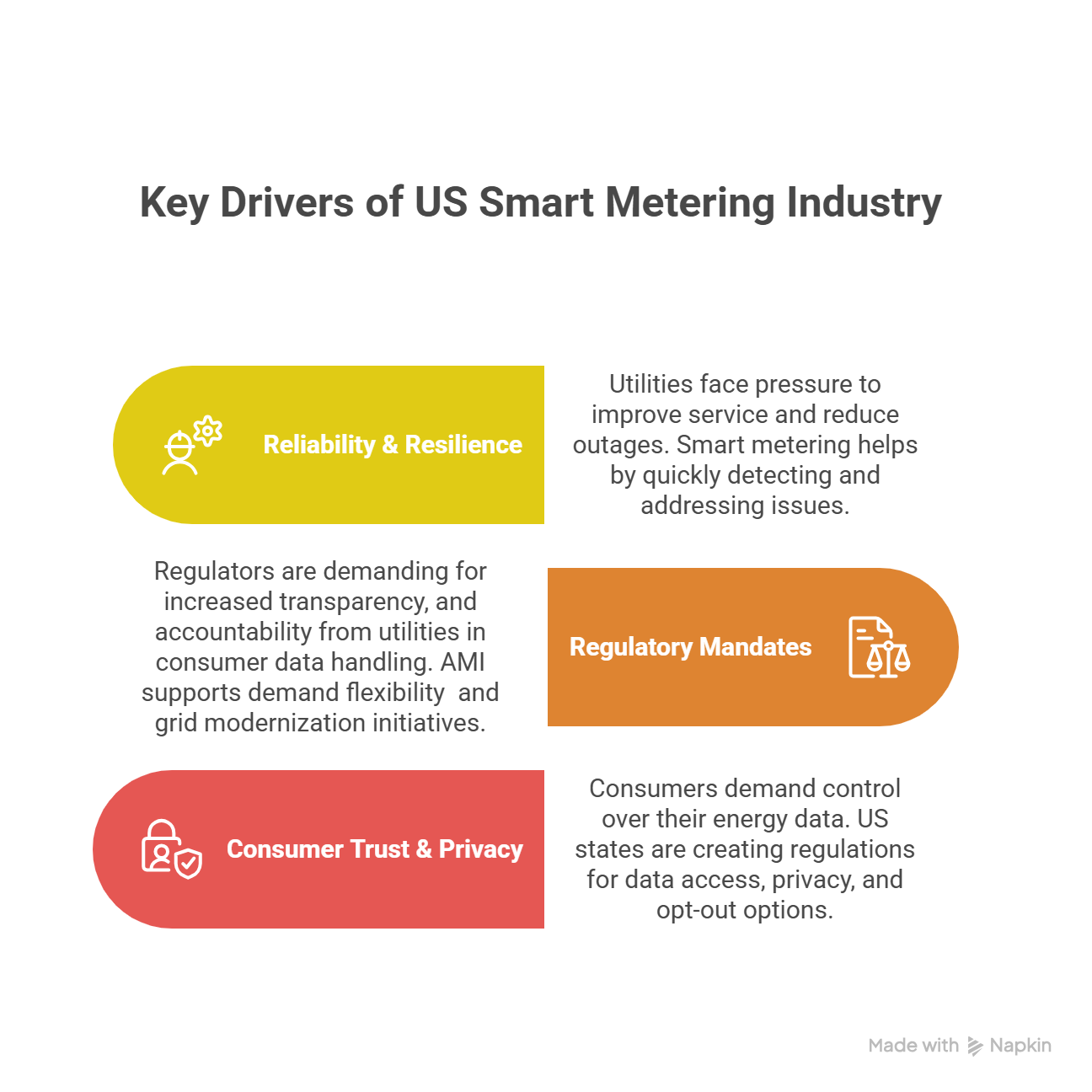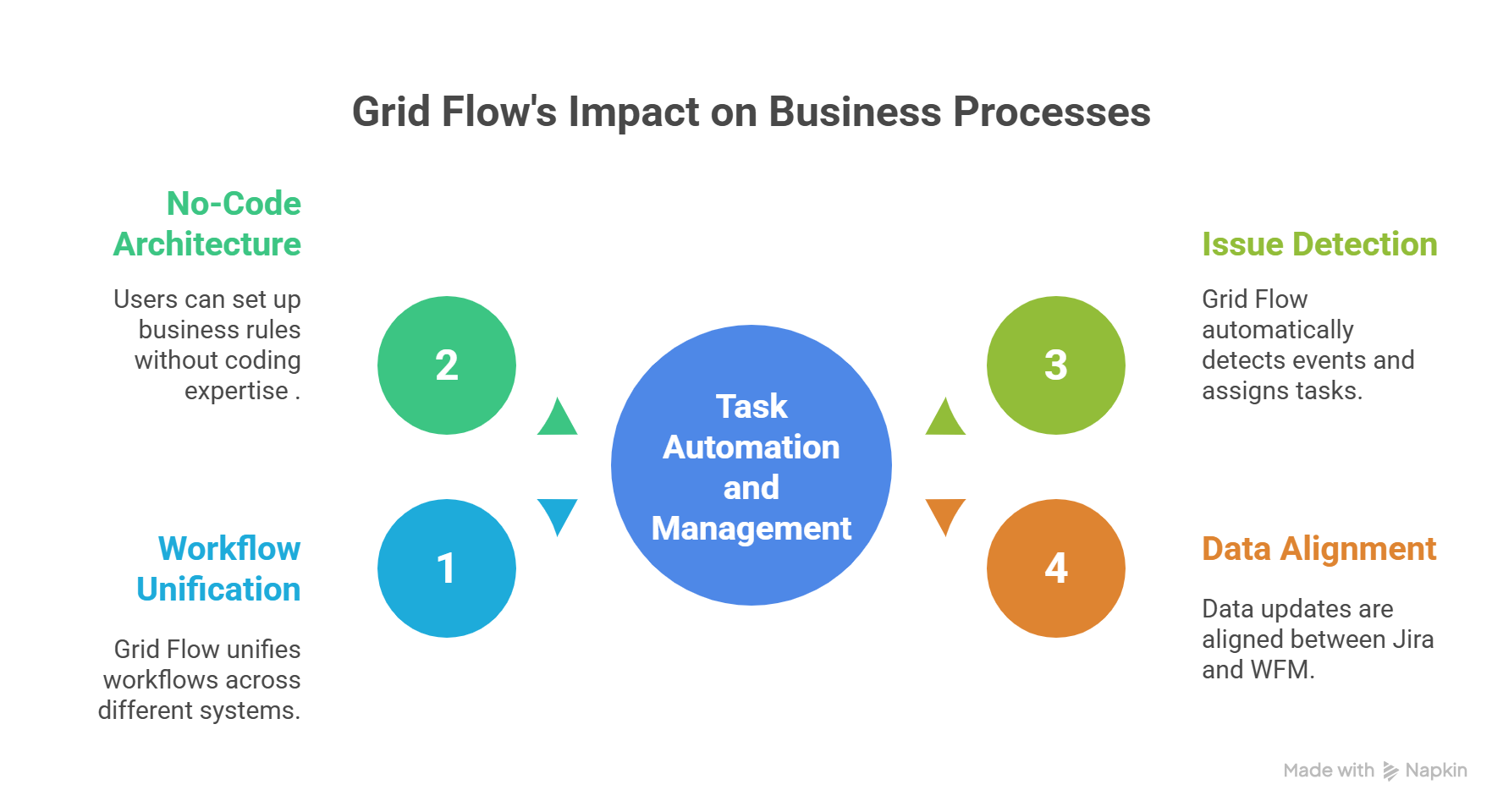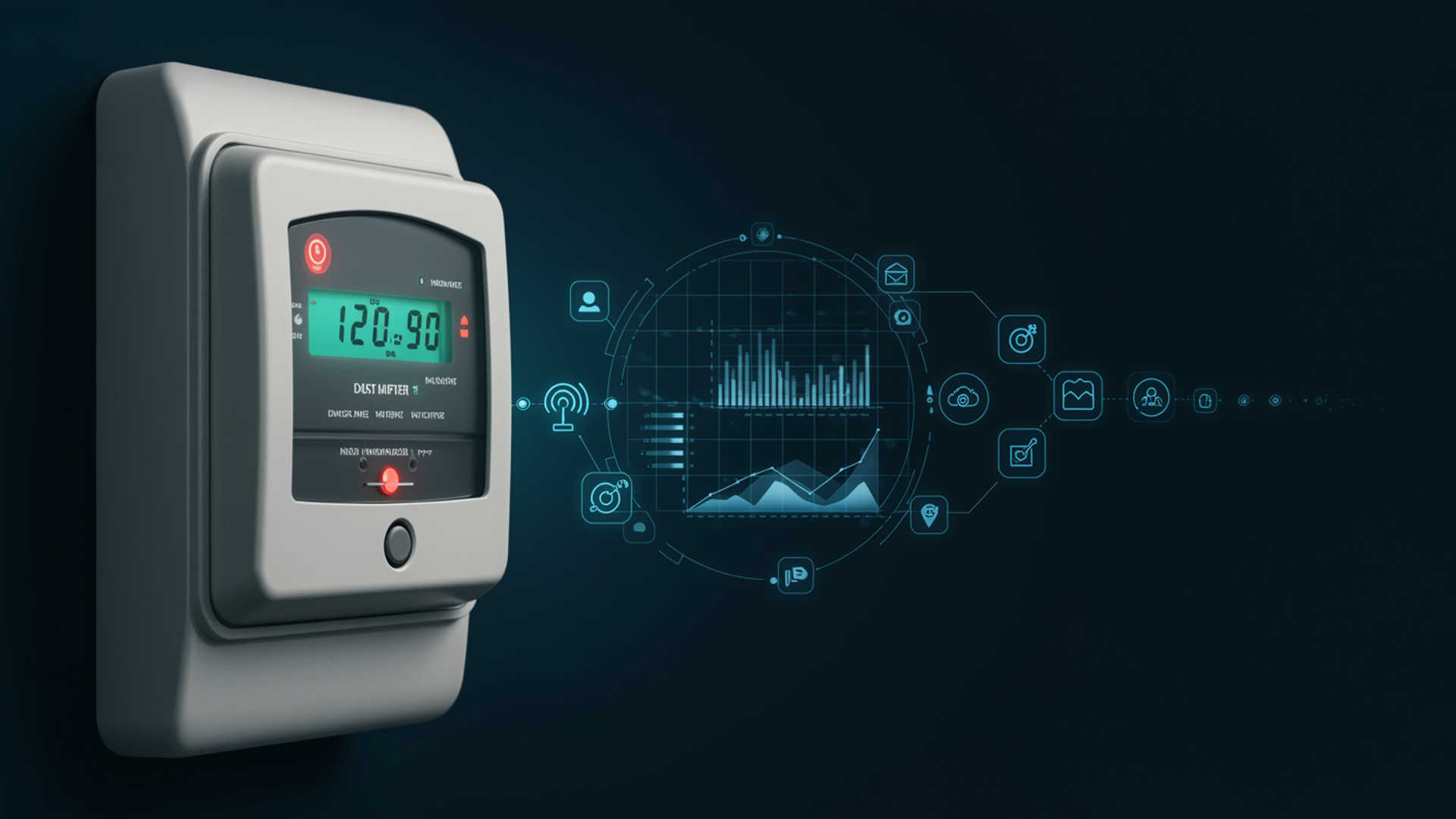Executive Summary: Why Smart Metering Matters to Utilities?
When we talk about smart utility metering, it is not just another step in digital transformation or a technological upgrade. It represents a connected enterprise ecosystem that unites metering, data, and operations into one intelligence layer. With modern smart metering solutions that provide visibility into near real-time information, the onus lies on utilities how they leverage that data. The real differentiator would be how meter data is organized, governed and monetized across operations and billing.
Key industry statistics:
- As per US Energy Information Administration, smart meter penetration in US households stood at 72% by 2023
- IoT Analytics indicates that smart meters accounted for 43% of global electricity meter market as of 2023
- The installed base of smart meters in North America is set to grow at a CAGR of 3.8%, as per a study by Business Wire.
- However, bodies like the US Department of Energy have cited persisting integration challenges exist within utilities that are preventing maximum utilization of smart metering data.

The next step for US utilities is to develop frameworks that push beyond mere focus on meter installation projects. In this guide, we will explore how utilities can make most of their metering data, and how platforms like Grid play a pivotal role in that context.
Smart Utility Metering as an Operational Framework
What does it really mean?
Smart utility metering goes beyond the action of collecting and reading data. It can be referred to as a strategic integration layer connecting AMI (Advanced Metering Infrastructure) and utility systems such as OMS, CIS, WFM, SCADA, etc.
Generally, data in traditional AMI projects stops at collection and reporting. In contrast, smart metering uses that same data to drive operational intelligence at scale. It links every function and provides cross-domain visibility within the AMI ecosystem.
How this integration provides enterprise-wide visibility
1. Planning and Asset Health: Meter event logs support predictive maintenance activities before complete asset failures.
2. Billing and Assurance: Interval data from smart meters improves billing accuracy, eliminates estimation, and ensures better audit compliance.
3. Outage analytics: Real-time alerts combined with power event traces enable for faster root cause identification and restoration.
4. Workforce Operations: Modern WFM (Workforce management) systems automates task creation and routing for non-communication meters, improving service level accountability.
BPM (Business Process Management) solutions such as Grid Flow, illustrate how this orchestration works in action. Users can create automated workflows that respond to AMI anomalies like retrials, communication issues, validation of data before billing, etc. Utilities can eliminate their reliance on manual monitoring and instead provide operations teams with:
- Closed-loop automation across systems
- SLA transparency and dashboard view
- Reduced response times via auto-triggered tasks
At the end of the day, smart utility metering is about ensuring utilities become operationally smarter; aligning data, decisions, and accountability across departmental functions.
The layers of smart metering architecture
AMI smart metering operations are closely linked via three layers working together to turn raw data into actionable intelligence.
The Flow of Utility Metering Data through the Layers
Capture: Field layer devices operate in near real-time. They record data for consumption, voltage, and other events. Any abnormalities will be screened out before transmitting through embedded edge logic filters.
Converge: The Integration layer receives, validates, processes, and routes metering data into enterprise systems (CIS, OMS, WFM).
Act: The third layer consists of systems like a SMOC (smart meter operations center) or a BPM engine for task creation and management. They interpret insights, flag delayed reads, and authorize remedies.
Next-Gen AMI 2.0 Capabilities
New-age smart metering for electricity and water utilities go beyond visibility, creating capabilities that allow utilities to act in real-time:
Real-time event routing: Immediate visibility into events and faster (RC/DC) actions.
Low-latency APIs: Supporting real-time collaboration between field crews and data operations.
Auto SLA enforcement: Prioritized alerts and auto-escalations of breaches.
Edge analytics and micro-aggregation: On-device data validation procedure reducing loads on central processing.
Metadata enrichment: Adding contextual information (feeder, consumer type, geo-tag) for data compliance and reporting.
Together, each of these layers transform a static AMI network into an actual, living operational ecosystem. Data continuously flows between systems, teams, outcomes, empowering utilities to view, decide and act faster.
Key Drivers Shaping the US Smart Metering Utility Industry
Anticipated Reliability & Resilience Pressure
Electric utilities today are under increasing pressure and scrutiny from regulators and customers to enhance service reliability and reduce outages. A study conducted by Powerline Magazine has shown that utility system reliability has worsened over the last decade. As a result, utilities are now being strictly assessed by targets associated with SAIDI, SAIFI and CAIDI.
Smart utility metering seeks to increase utility resilience by reducing detection-to-restoration loops.
- Metering data captures voltage sag events at high frequencies, without pause.
- This allows utilities to triage and dispatch outage analytics faster than if they were to wait for customers to report the issue.
- Over time, this reduces both SAIDI and SAIFI, pushing utilities closer to their targets.
Regulatory Mandates, ESG & Data Transparency
Federal and state regulators are mandating increased access to data as well as greater transparency and accountability.
- The DOE DER interconnection roadmap notes that the degree of data access and transparency varies considerably among U.S. utilities.
- At the same time, reports from FERC (Federal Energy Regulatory Commission) emphasize that advanced metering must support demand flexibility and grid modernization.
The shift in dialogue is pushing utilities to implement data assurance frameworks, from audit trails and integrity checks, to data provenance, with metering data becoming key to regulatory and ESG reporting.
Consumer Trust, Privacy & State-Level Mandates
Consumers today expect greater control over their energy data. As a result, various states are creating regulations that require consumer access to interval data, privacy measures, and opt-out options.
- Take Michigan’s MPSC rules for instance, which calls for utilities to implement data privacy frameworks to safeguard consumer data against third-party distribution.
- The US Department of Energy emphasizes that consumers are provided control on who can access their data, with opt-in consent made mandatory.
Utility solutions for smart metering must incorporate features like role-based access, anonymization, and detailed logs. These measures can help minimize risks of data misuse while protecting the rights of the consumer.

Risks in Utility Metering Governance: Beyond Cybersecurity
Data accountability gaps in utility operations
For many U.S. utilities even today, data accountability still exists within a grey area. Teams across metering, IT, and operations work in separate silos. So, who exactly is responsible for AMI data quality, traceability, and usage rights?
- According to the U.S. Department of Energy’s Grid Modernization initiative, challenges around data governance and integration persist even as utilities continue to operationalize AMI data across systems.
Modern smart utility metering frameworks introduce auditable workflows that create traceability in everyday operations. They capture who performed what, when, and why.
Solutions like Grid SMOC are specifically designed to establish this digital paper trail.
- Every command, retries, or read integrity checks are logged automatically.
- Task ownership is assigned, updated, and confirmed in real-time.
- Compliance teams are able attain complete visibility across systems, resulting in every meter event or outage resolution can be reconstructed from start to finish.
This level of operational transparency converts raw AMI data into verifiable accountability; foundation for any utility considering a data governance framework.
Cybersecurity and Compliance: Transitioning from Risk to Governance
When we talk about cybersecurity in smart utility metering, it includes both encryption and compliance. Utilities must comply with regulatory standards such as NERC CIP (Critical Infrastructure Protection), ISO 27001, and the DOE’s Cybersecurity Capability Maturity Model (C2M2). All of these governance frameworks recognize and require utilities to treat consumer meter data as critical to metering infrastructure.
Examples of cybersecurity best practices are:
- AES-256 encryption and periodic key rotation.
- RBAC (role-based access control) based on the least-privilege principle.
- Integrity checks between HES, MDM, and data warehouse layers to prevent data tampering.
Instead of building a narrative of fear showing how bad attacks could be, utilities must focus on continuously automating compliance. Utility solutions like Grid come with a governance-ready architecture automating compliance checking and exception tracking. This allows utilities to connect with NERC CIP and ISO 27001 security frameworks through auditable, repeatable workflows.
Avoiding vendor lock-In through contractual governance
A risk that often goes unnoticed is vendor dependency over time. Proprietary HES or MDM ecosystems can limit data access and add excessive costs to upgrades.
Industry associations like NIST are advocates of open standards like DLMS/COSEM and API-first architecture to ensure flexibility in vendor choices.
Utilities drafting new AMI contracts should integrate clauses that address the utility's:
- Right to migrate or export all historical AMI data in non-proprietary formats.
- Full API documentation and interoperability testing prior to deployment.
- Clear ownership and custody of data in SLAs.
By adopting smart utility metering, in conjunction with a governance-first approach, utilities can turn risk into resilience. This results in building secure, interoperable and future-proof operational ecosystems that protect information as well as trust.
Grid Case Study: Task Automation and Management with Grid Flow (BPM Engine)
Challenge:
A U.S. utility with 800,000+ smart electric meters faced challenges with numerous workflows running independently between their HES, MDM, and billing system.
Events such as non-reporting meters, delayed reads, and unusual consumption patterns, required human intervention. This caused delays, data reconciliation issues, and slowed down operations.
Grid Solution:
The utility implemented Grid Flow, our BPM (Business Process Management) solution to unify workflows across metering, billing, and work management systems.
With the platform’s no-code architecture, users set up multiple business rules to automatically detect issues, trigger a retry or escalation task, and align data updates between Jira and WFM.
Measurable Outcomes:
- 30% faster detection to resolution for event resolution
- 25% improvement of billing accuracy
- 8+ hours saved per analyst per week
- 20% higher field efficiency achieved

FAQs (Frequently Asked Questions)
What is smart utility metering and how does it differ from basic smart metering?
Smart utility metering refers to the full operational integration of AMI with utility systems (OMS, CIS, WFM, SCADA), turning meter reads into real-time insights and workflows. When we talk about smart metering, it refers mainly to meter deployment and data collection. The main difference lies in actionability and orchestration across operations, and not just limited to smart meters themselves.
What are the benefits of smart utility metering for U.S. utilities?
Key benefits for utilities include enhanced outage response, improved billing accuracy, optimized asset health, and stronger regulatory compliance. For instance, real-time event routing capabilities minimize detection-to-restoration timelines, while interval data minimizes billing estimation errors.
Does smart utility metering support ESG reporting and regulatory compliance?
Smart metering data is critical to regulatory compliance, transparency mandates, and ESG frameworks. By enforcing data provenance, audit trails, and metadata tagging, utilities can ensure compliance with standards such as FERC, DOE, and state rules. Smart utility metering ensures that meter data is trustworthy, traceable, and ready for audit or reporting.
What are common risks in metering governance, and how can utilities mitigate them?
Standard risks include data silos (lack of ownership), vendor lock-in, and cybersecurity breaches (tampering, unauthorized access). Mitigation strategies for utilities include adopting open standards (DLMS/COSEM, API-first), embedding auditable workflows vis solutions such as Grid SMOC, enforcing role-based access control, etc.
How do utility solutions like Grid Flow automate meter event handling and operational workflows?
With Grid’s BPM engine, utilities can define business rules without coding to automatically detect anomalies, trigger escalations, and synchronize data across billing and WFM systems. Utilities can minimize human dependency, fast track response times and ensure data integrity is maintained.
Is deploying smart utility metering costly and how can ROI justify it?
The investment of a smart utility metering includes integration, governance layers and data pipelines, making initial costs higher than traditional meters. However, long term benefits include reduced O&M costs, minimized human intervention, reduced billing disputes, and better regulatory adherence.
Conclusion: Turning Smart Utility Metering into Real-World Intelligence
As U.S. utilities continue to undergo modernization, smart utility meters have become the interconnected fabric of devices, data, and decisions. Yet, success relies not only on meter deployment, but making the most of data they collect and making informed decisions. Utilities that strike a balance of governance, automation, and accountability are positioned to lead the next evolution of operational excellence.
Solutions such as Grid Flow enable this evolution organically. Utilities can now combine fragmented workflows into automated, auditable processes that enhance service reliability and compliance with accountability. And all of this is achieved without disrupting the existing infrastructure.
Contact us at Grid today to learn how your utility can streamline integration, data governance, and performance tracking, as you build a smarter, more resilient grid.



.jpg)
.jpg)
.jpg)






